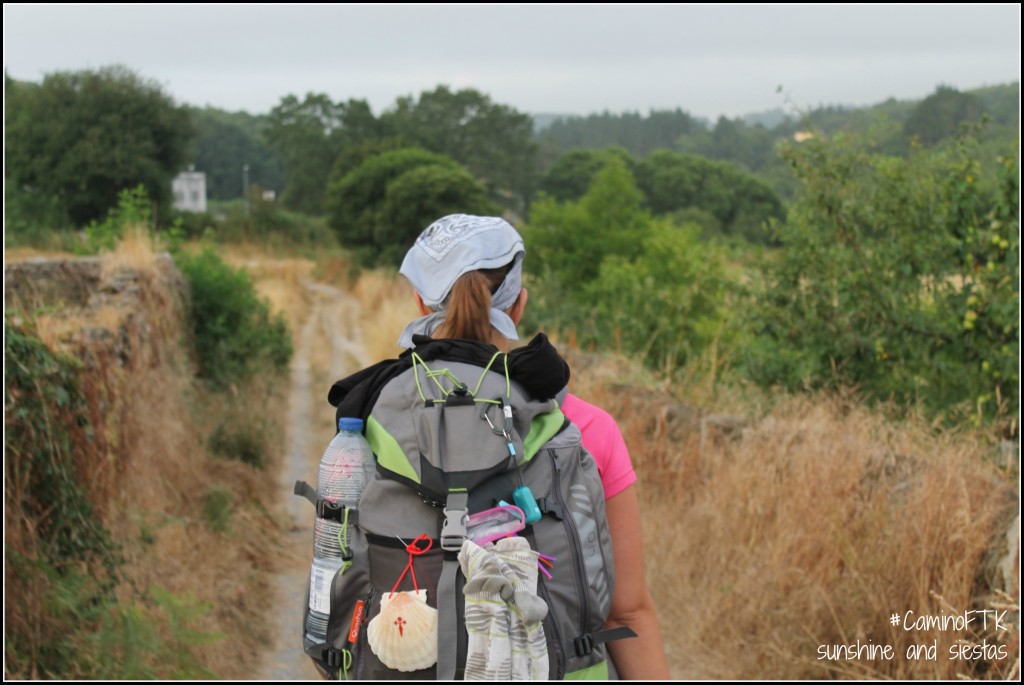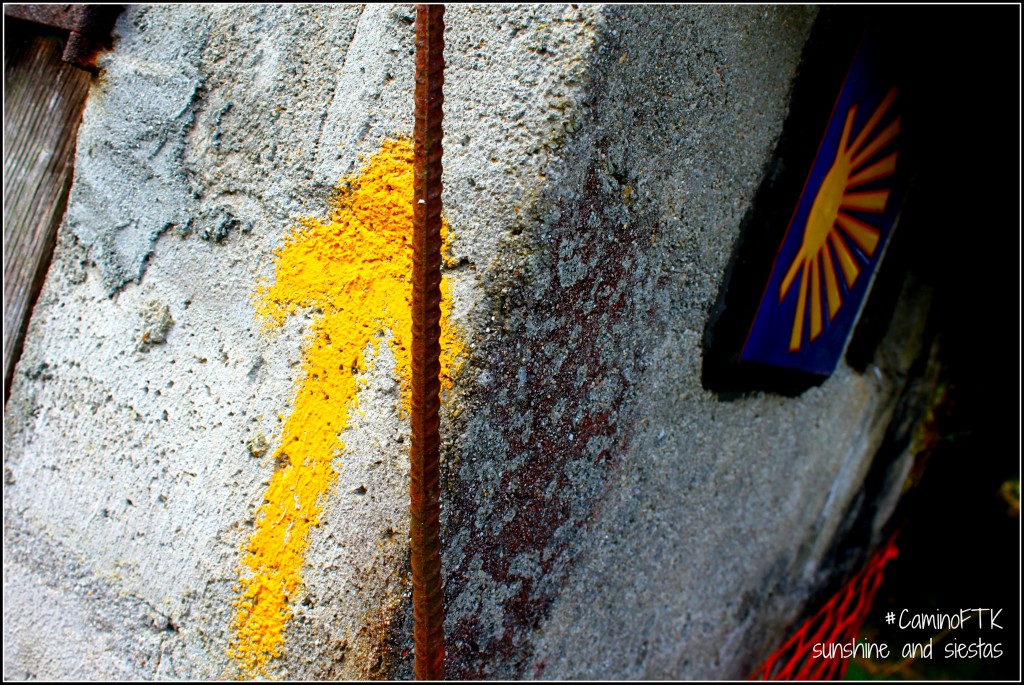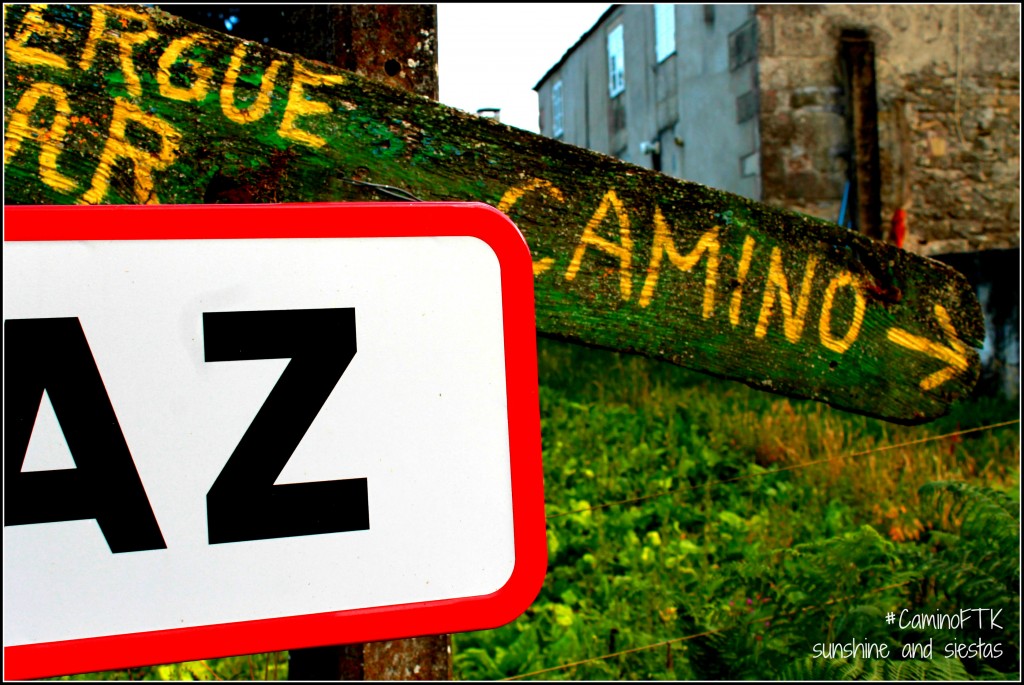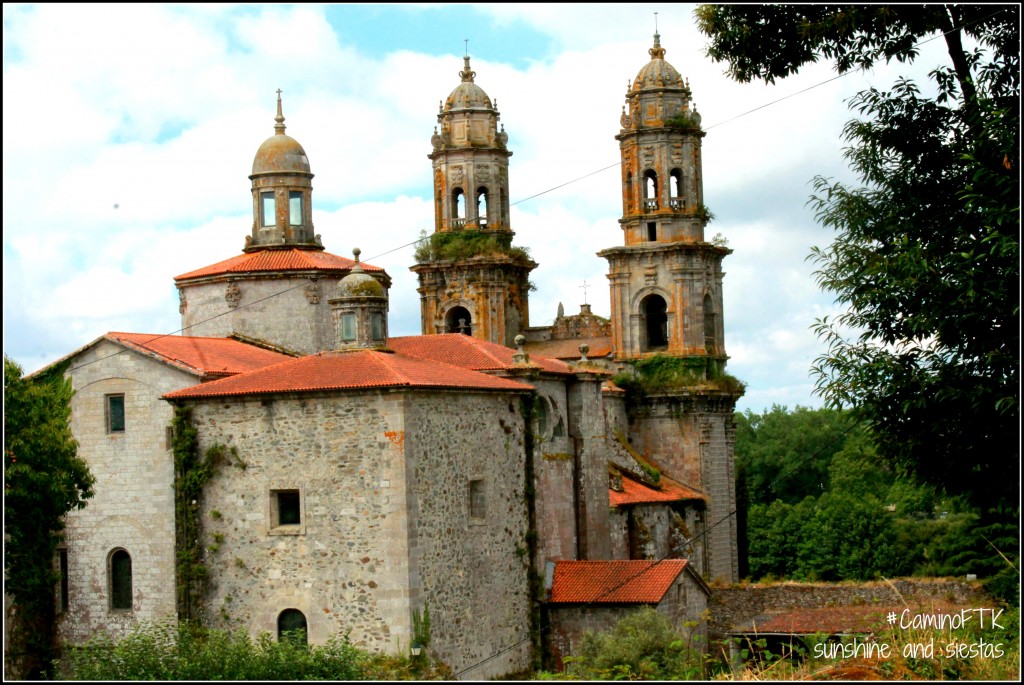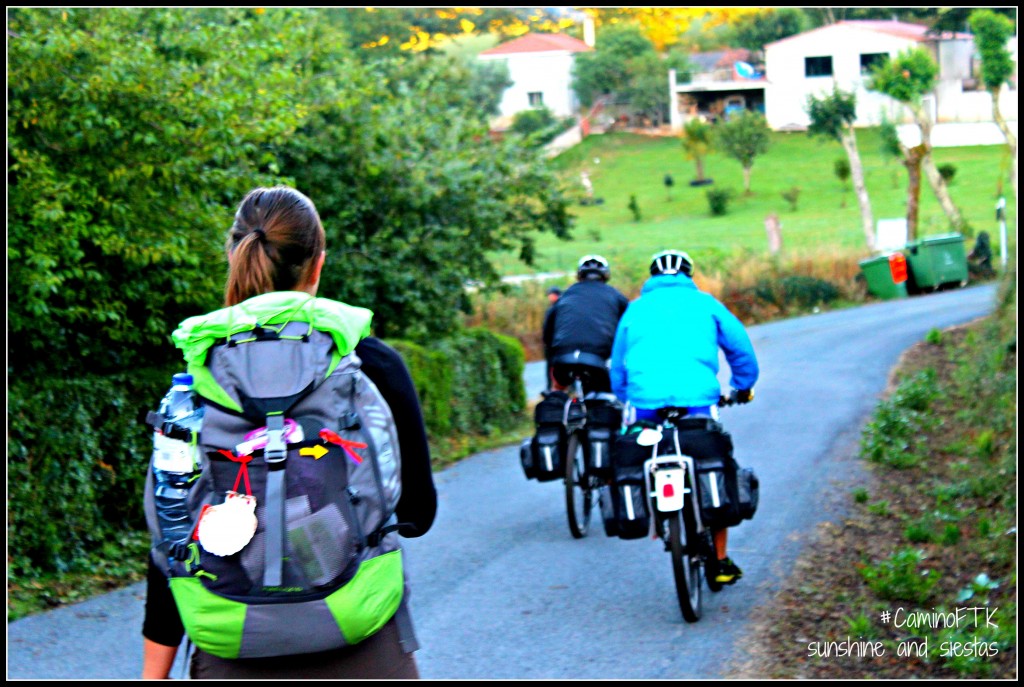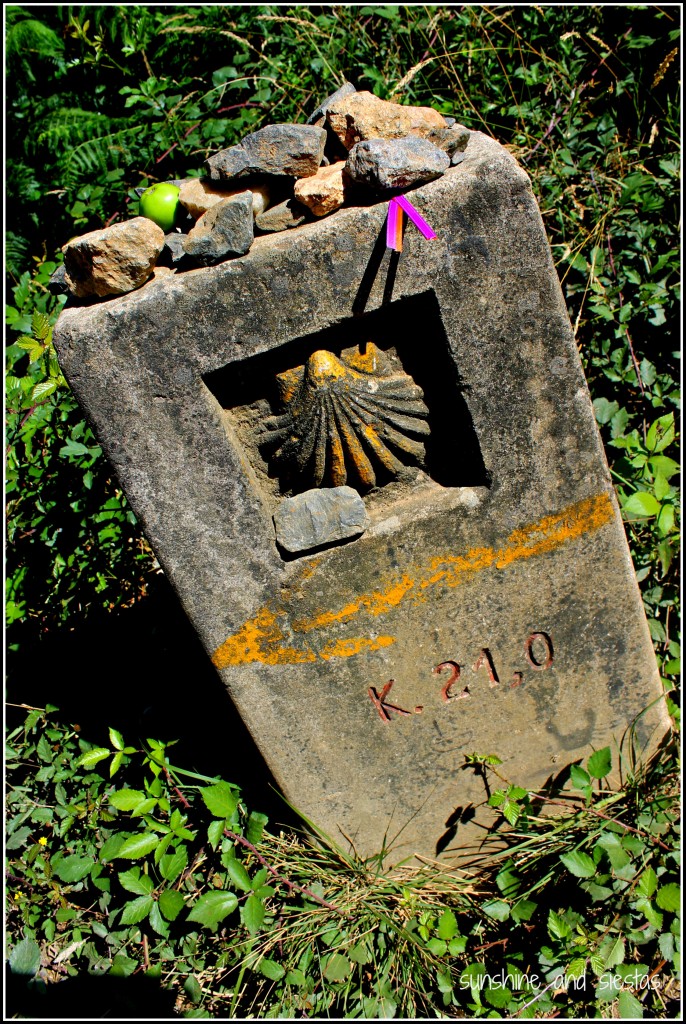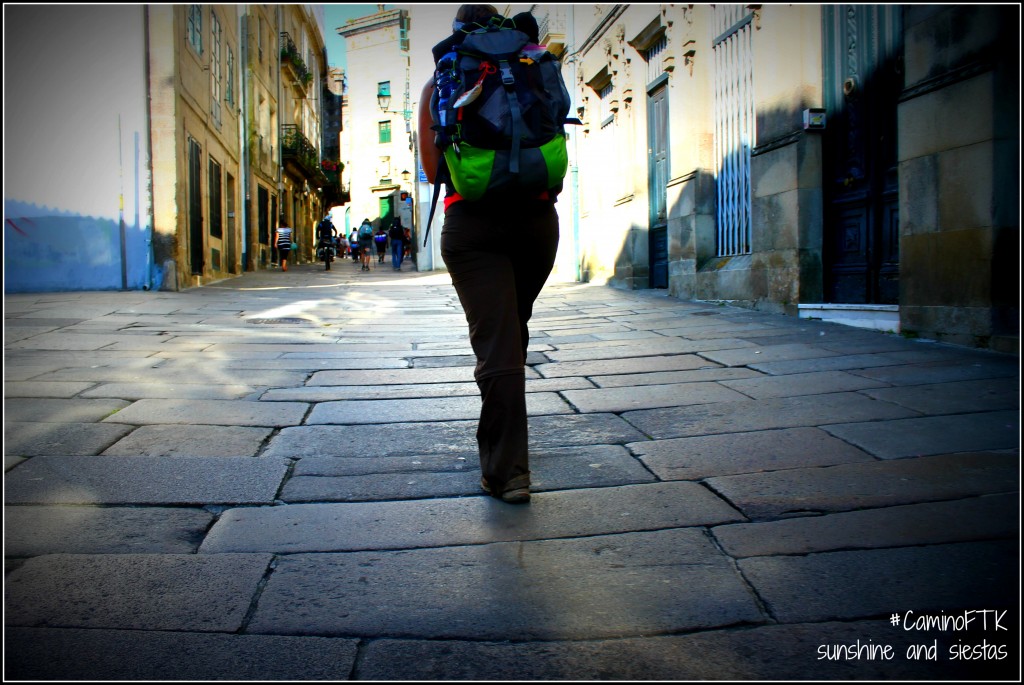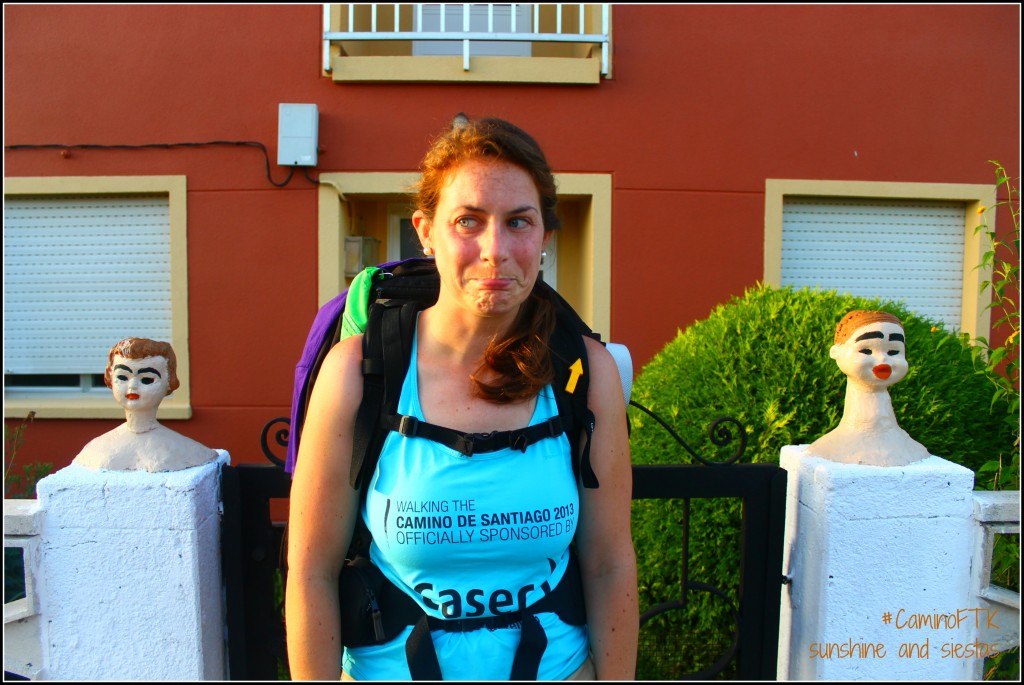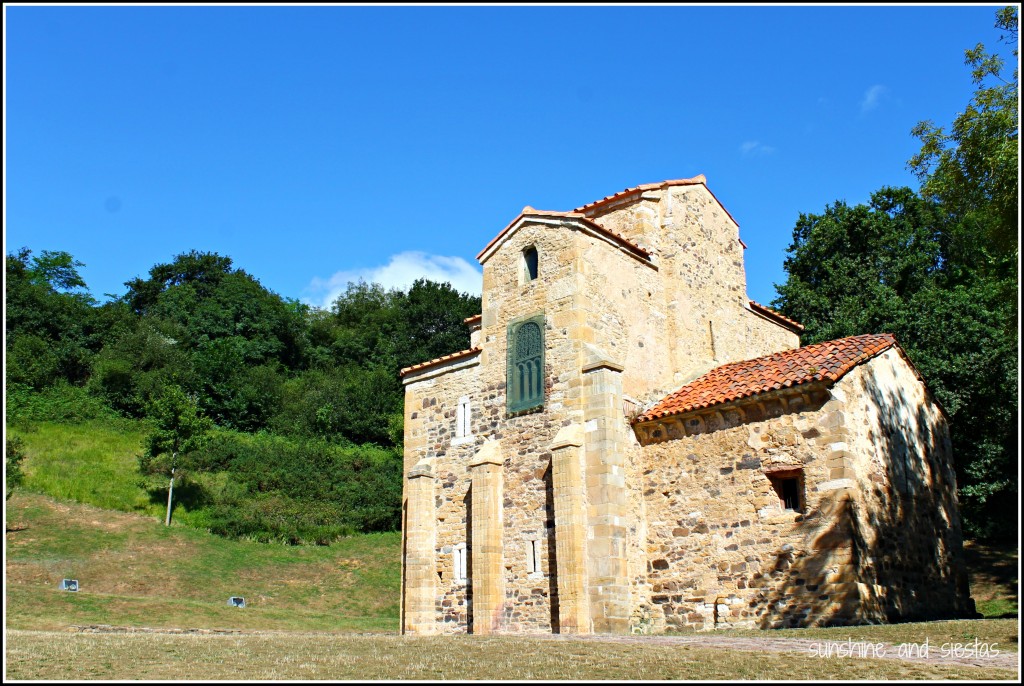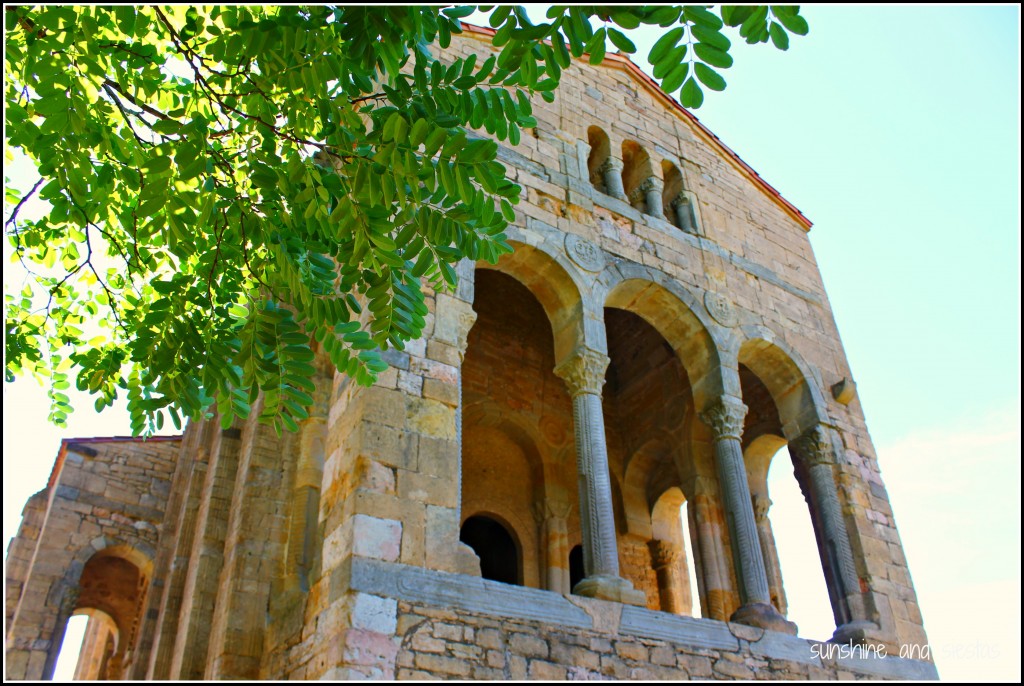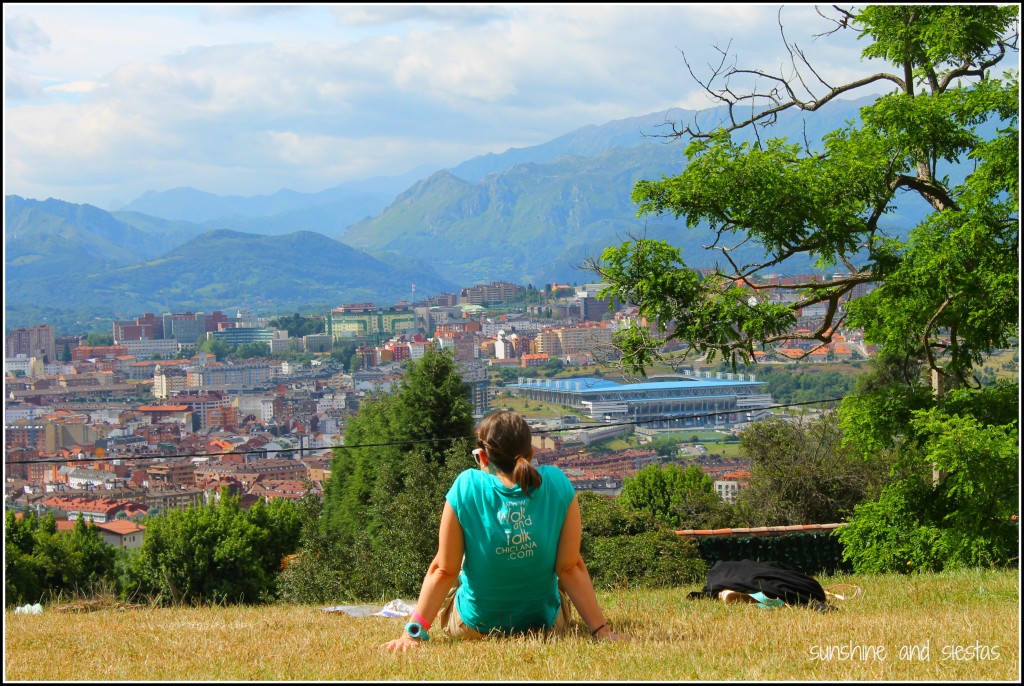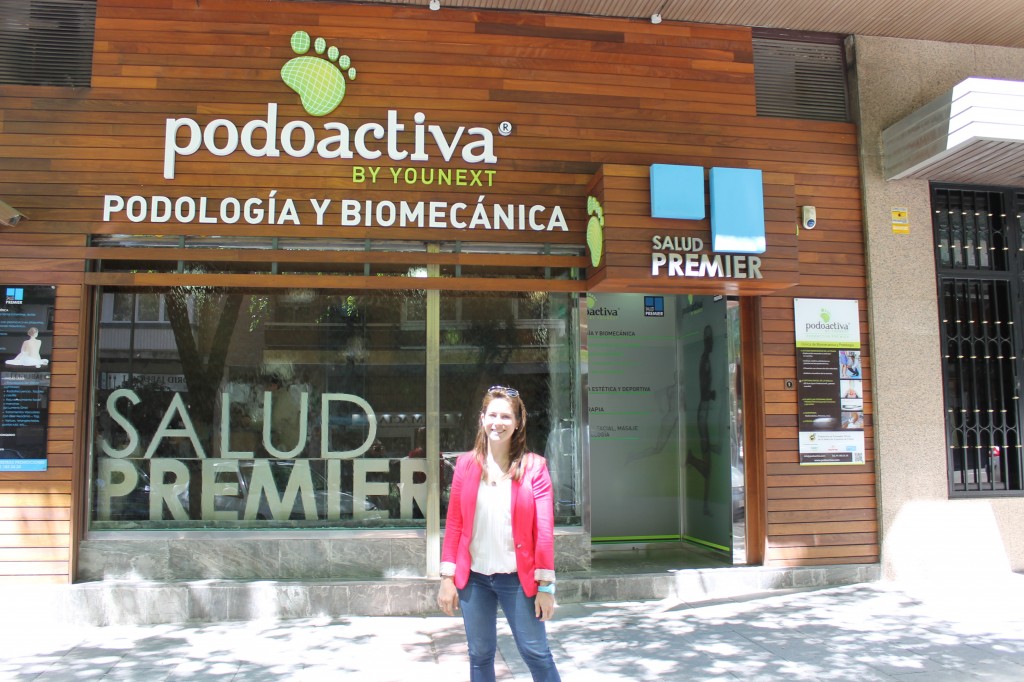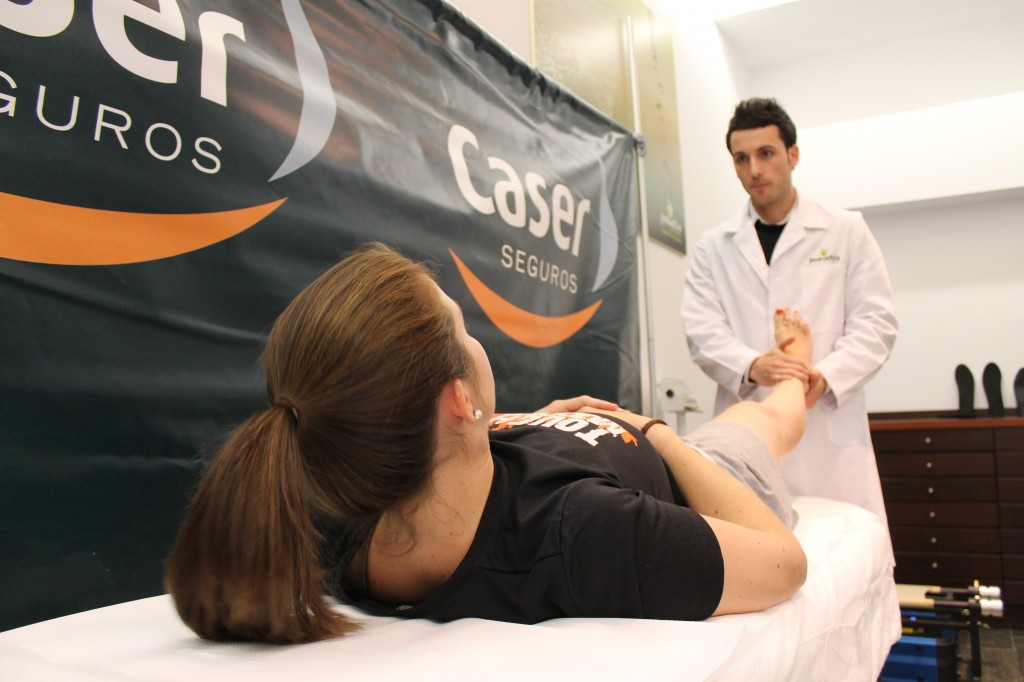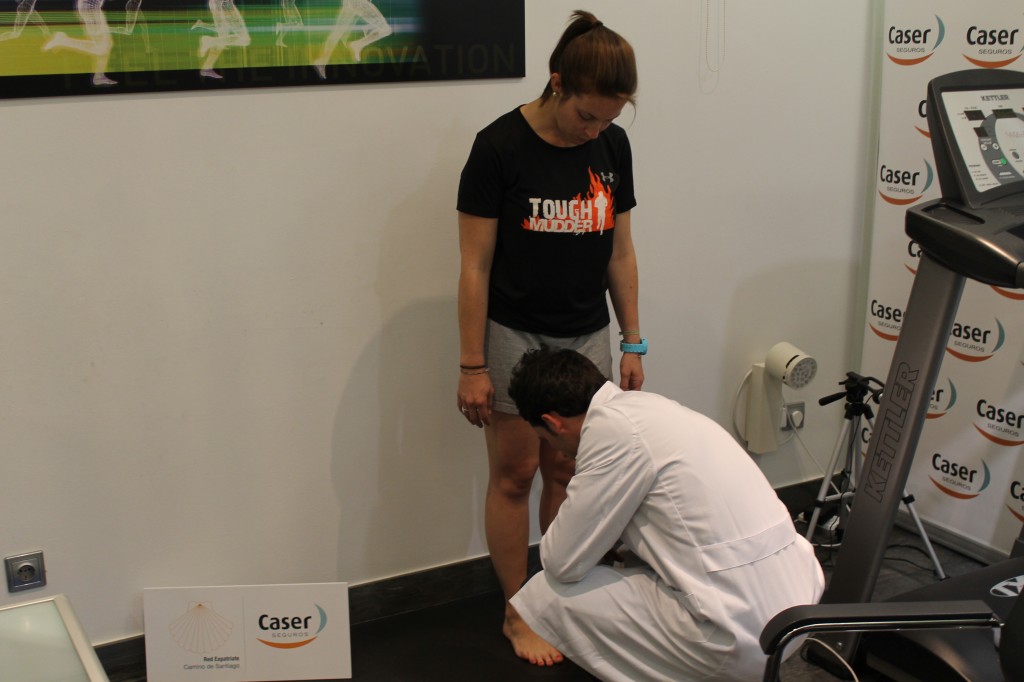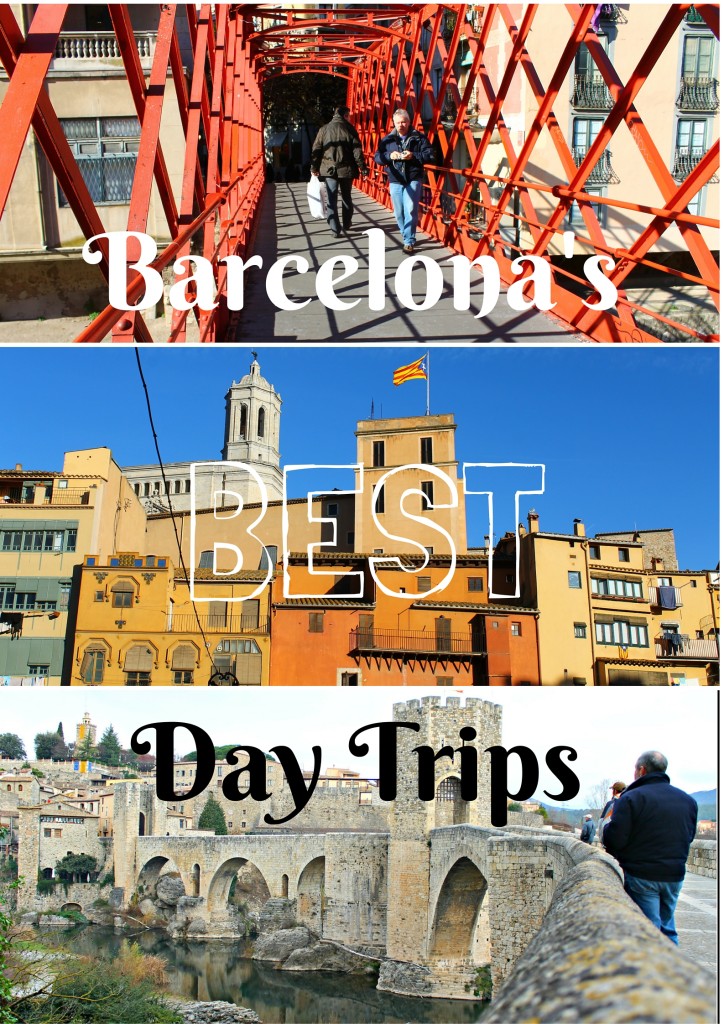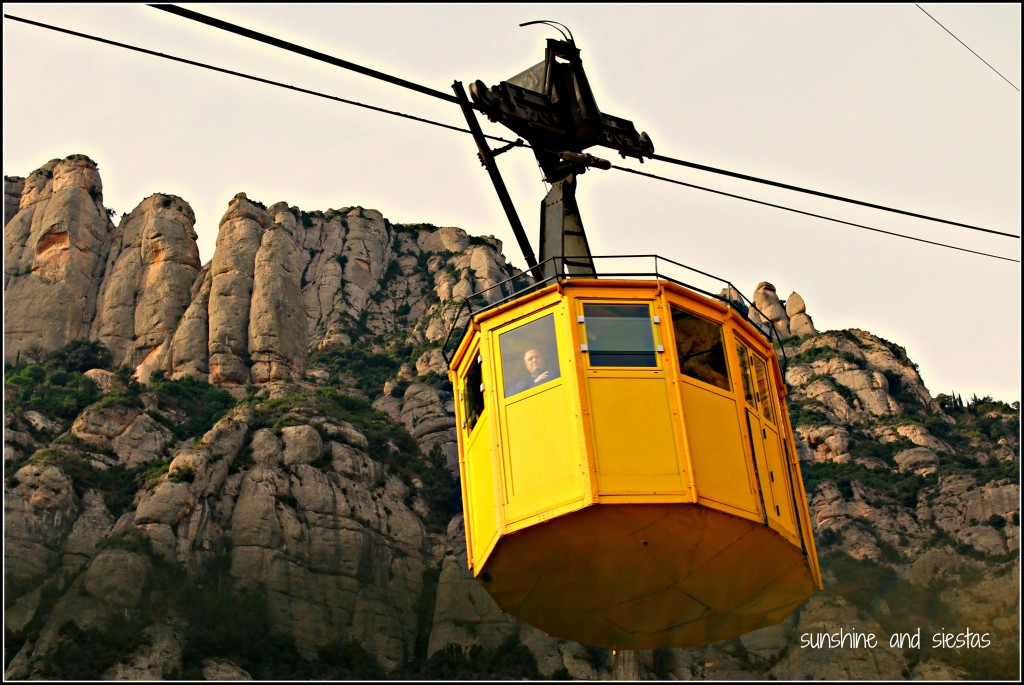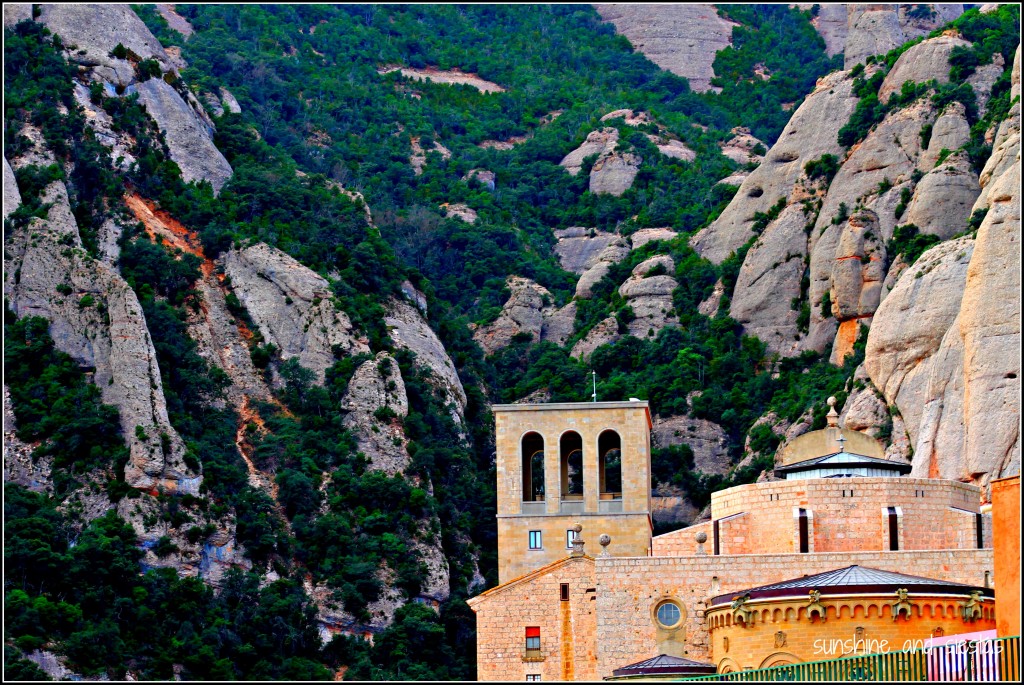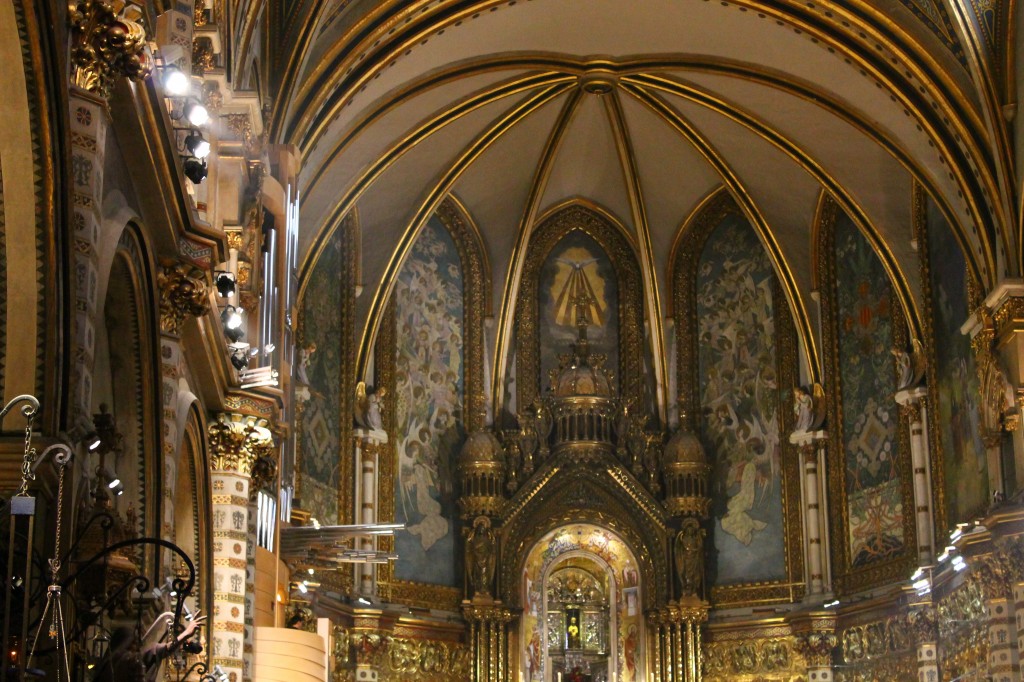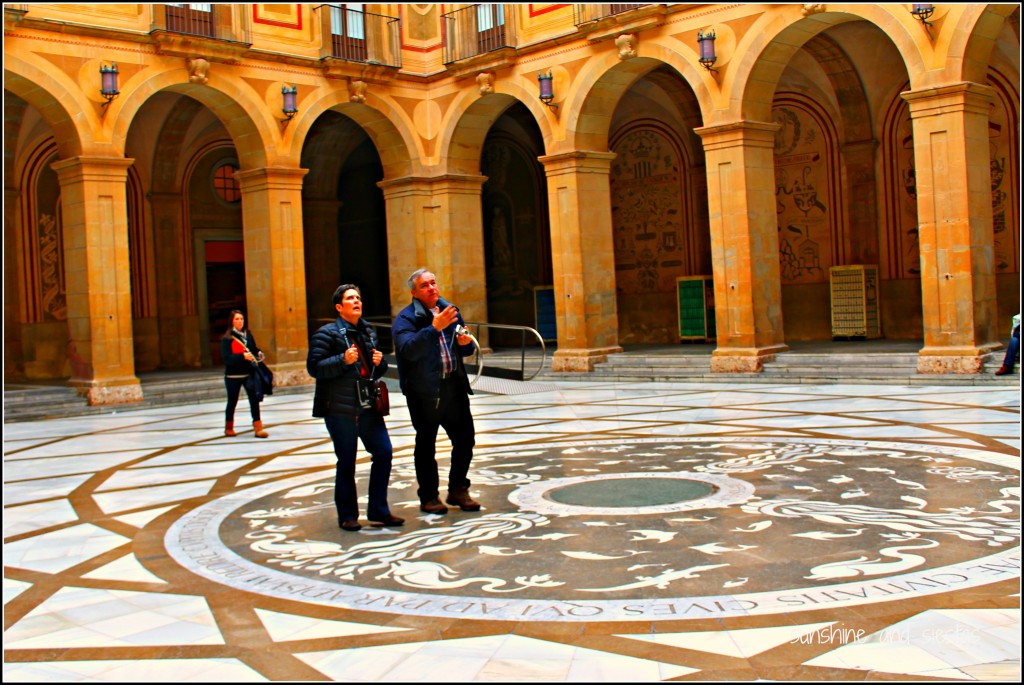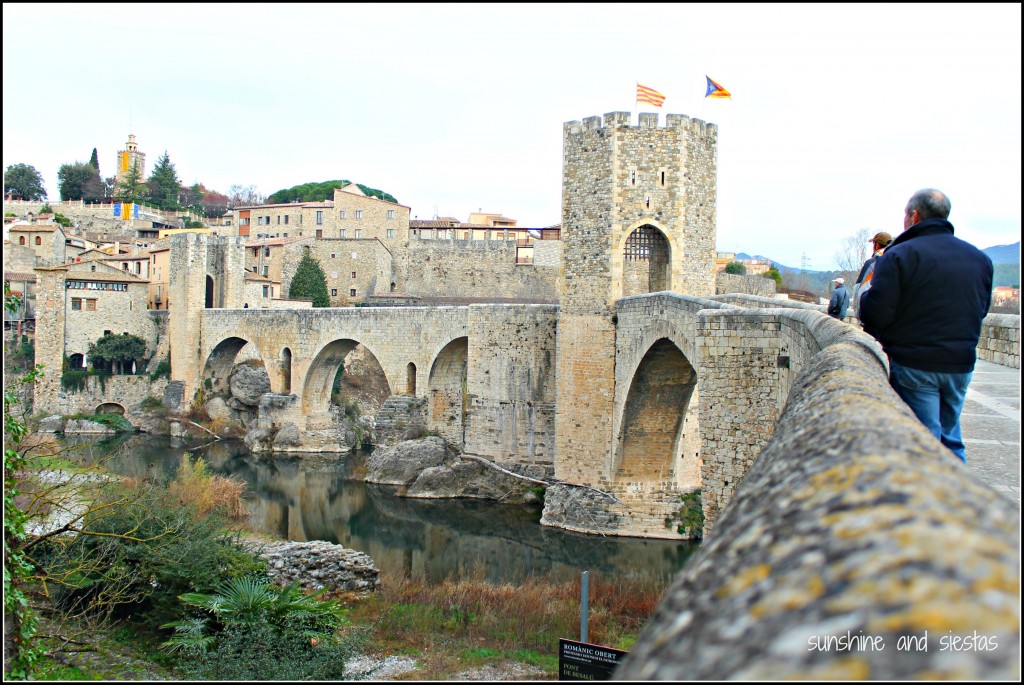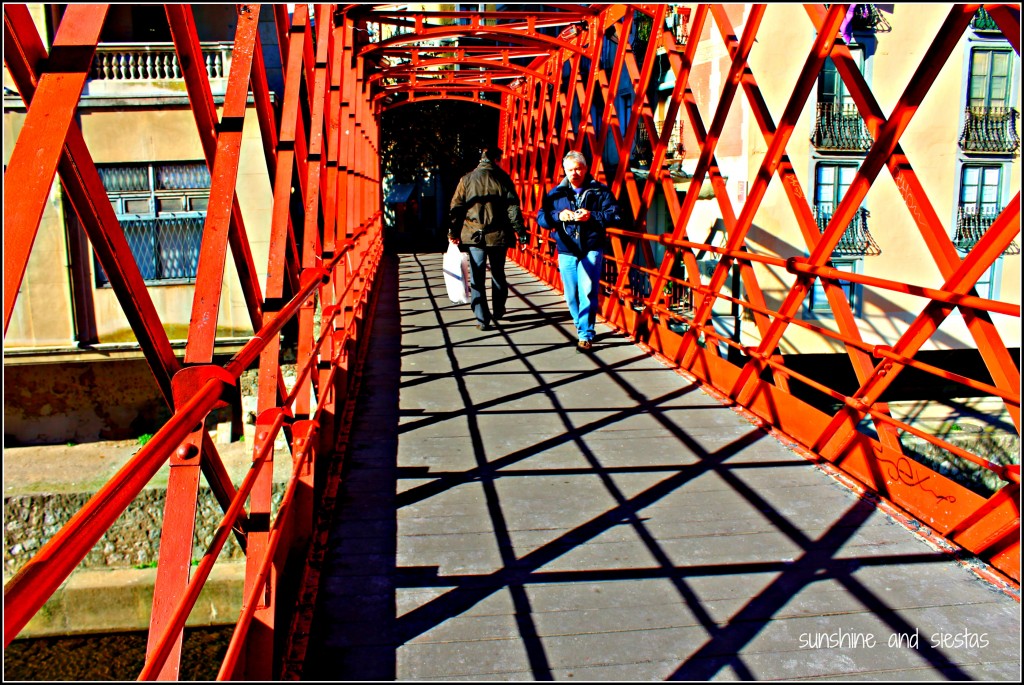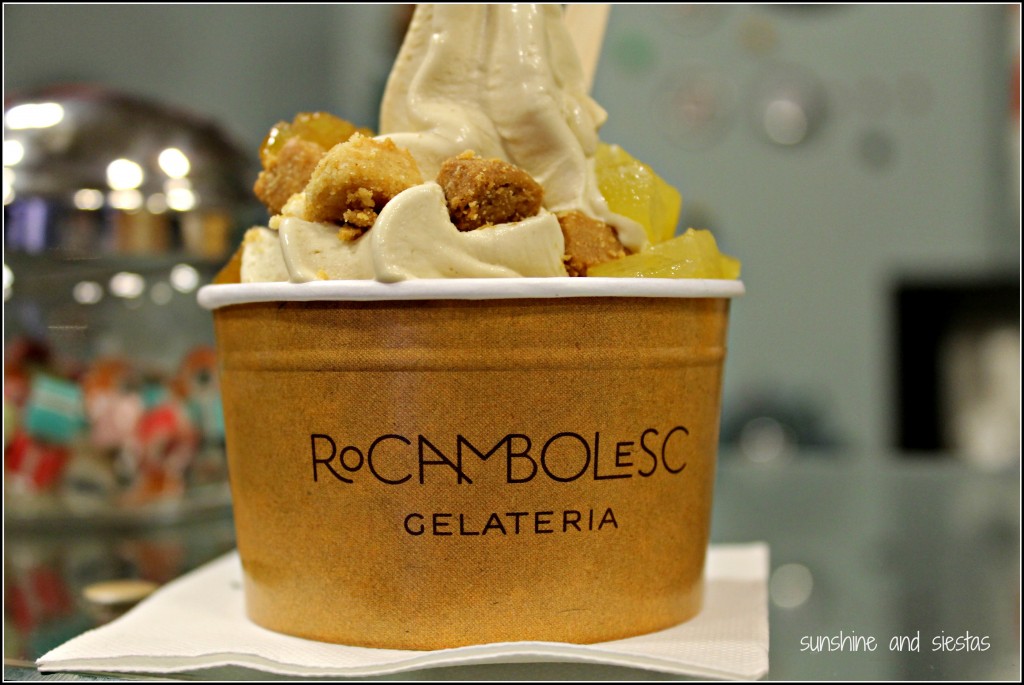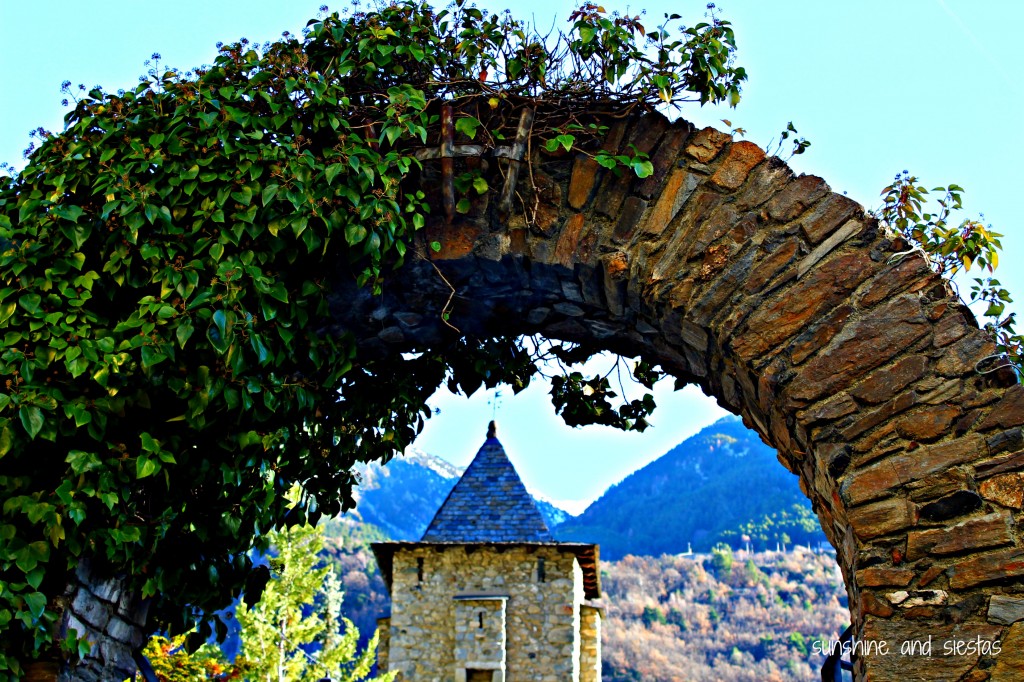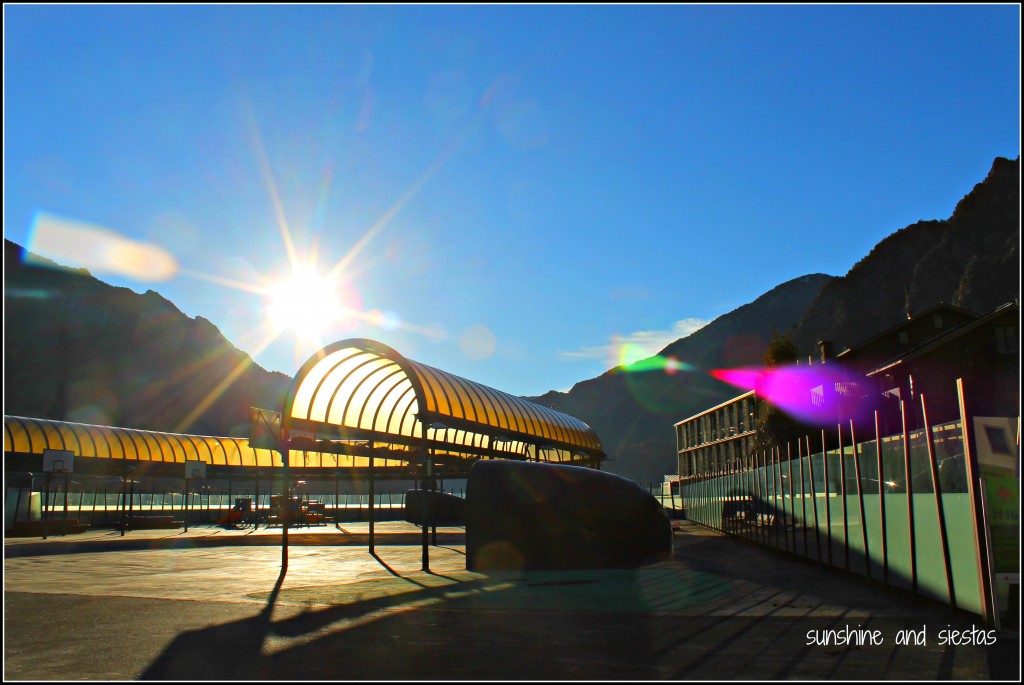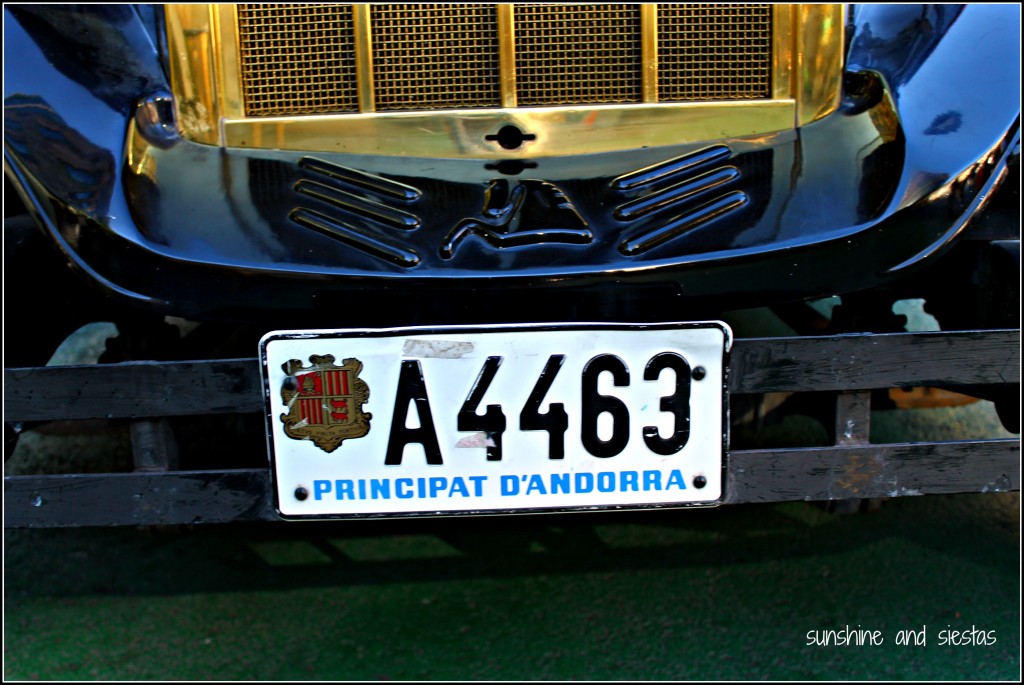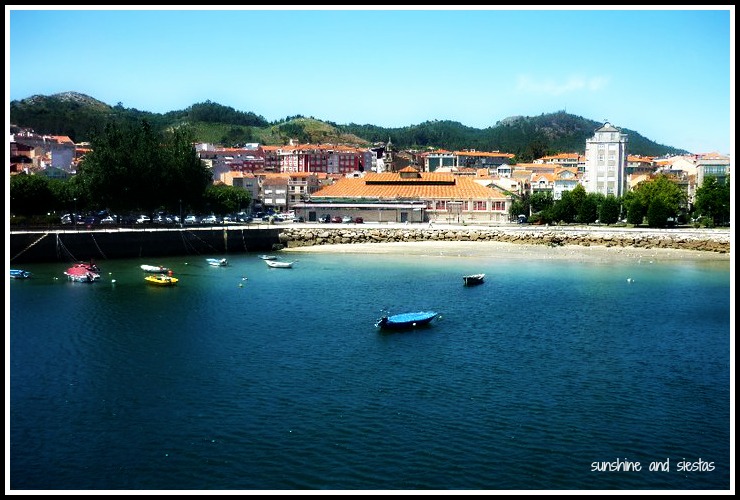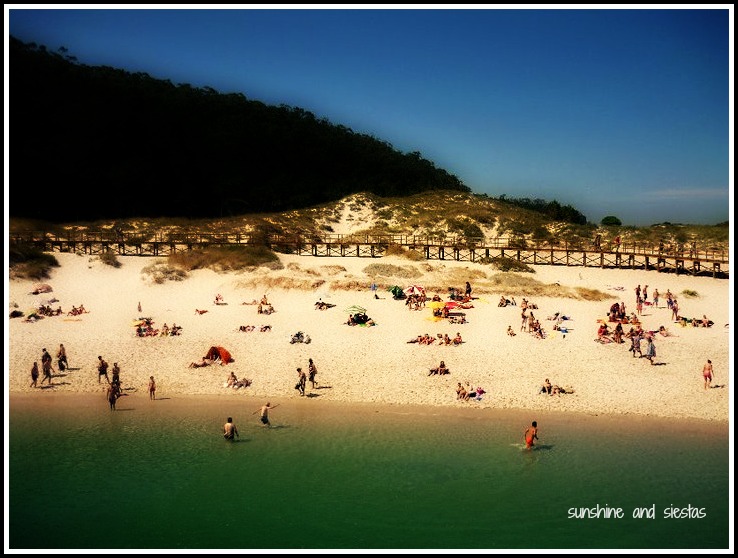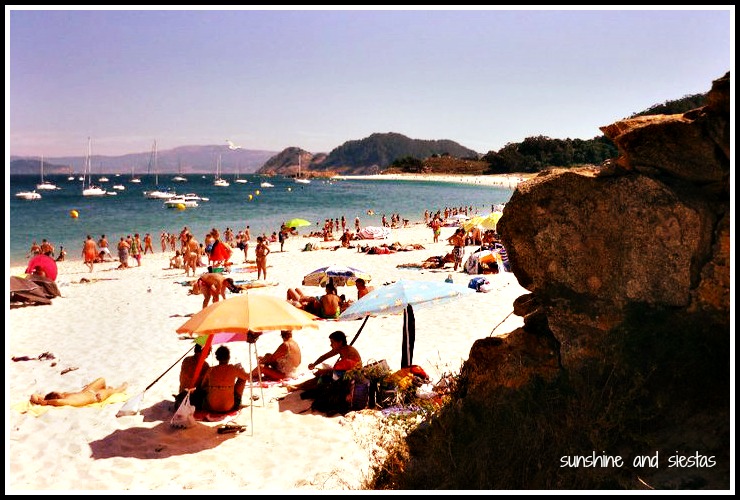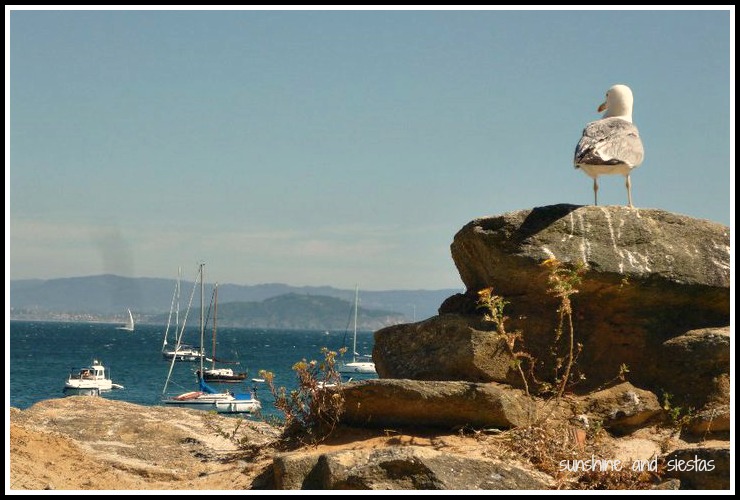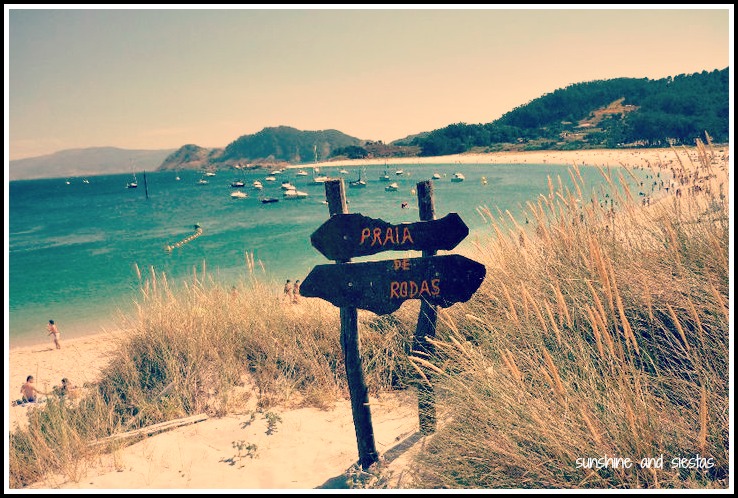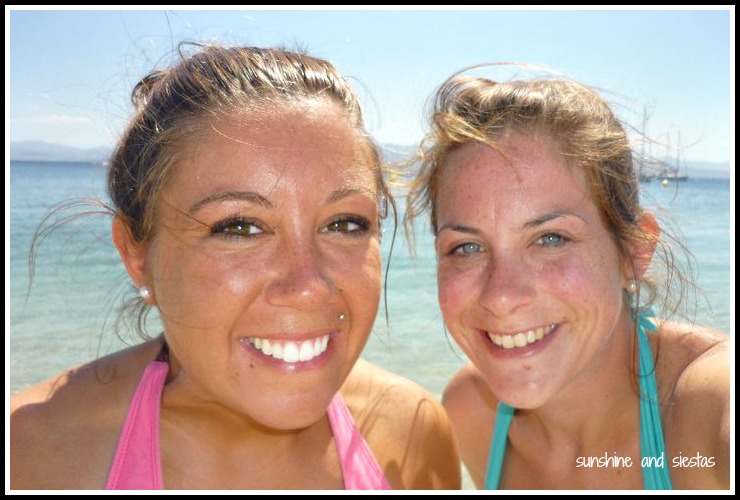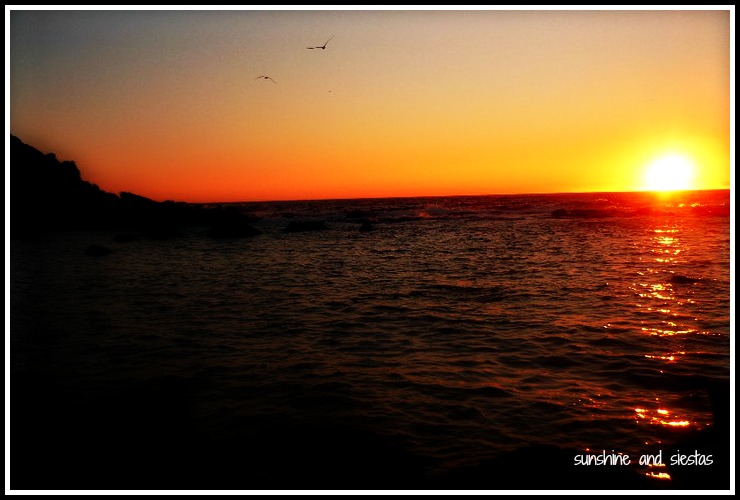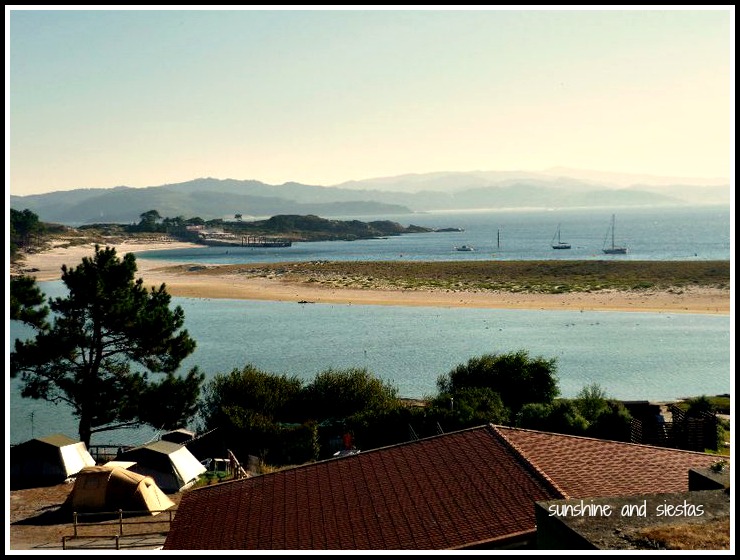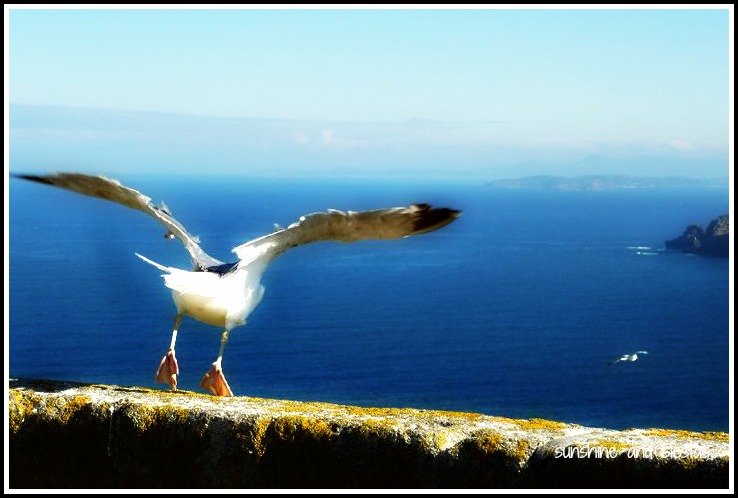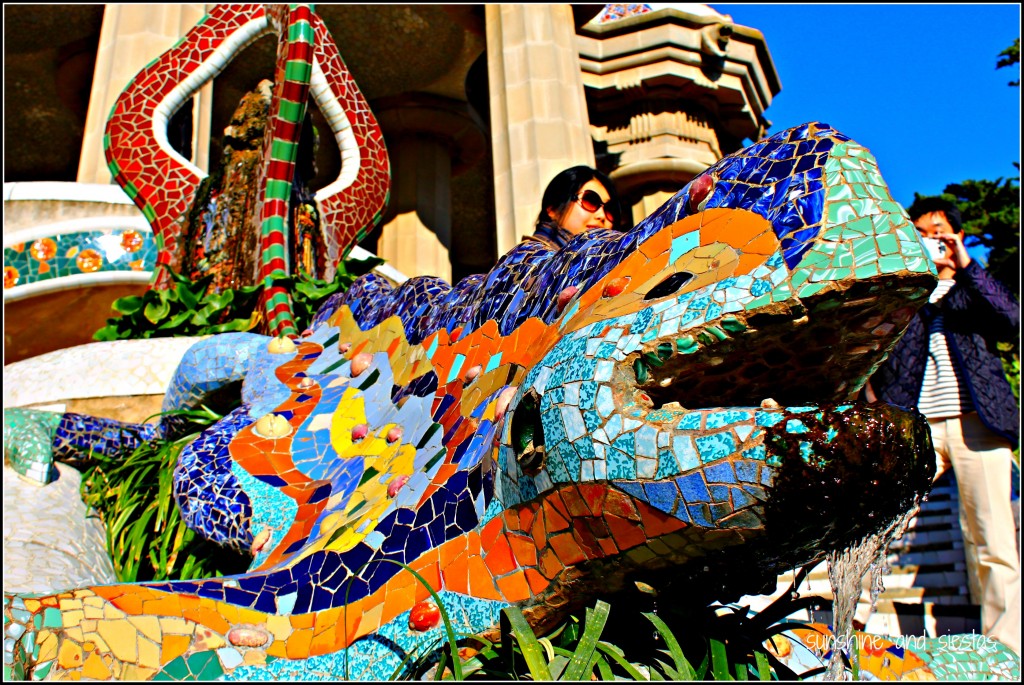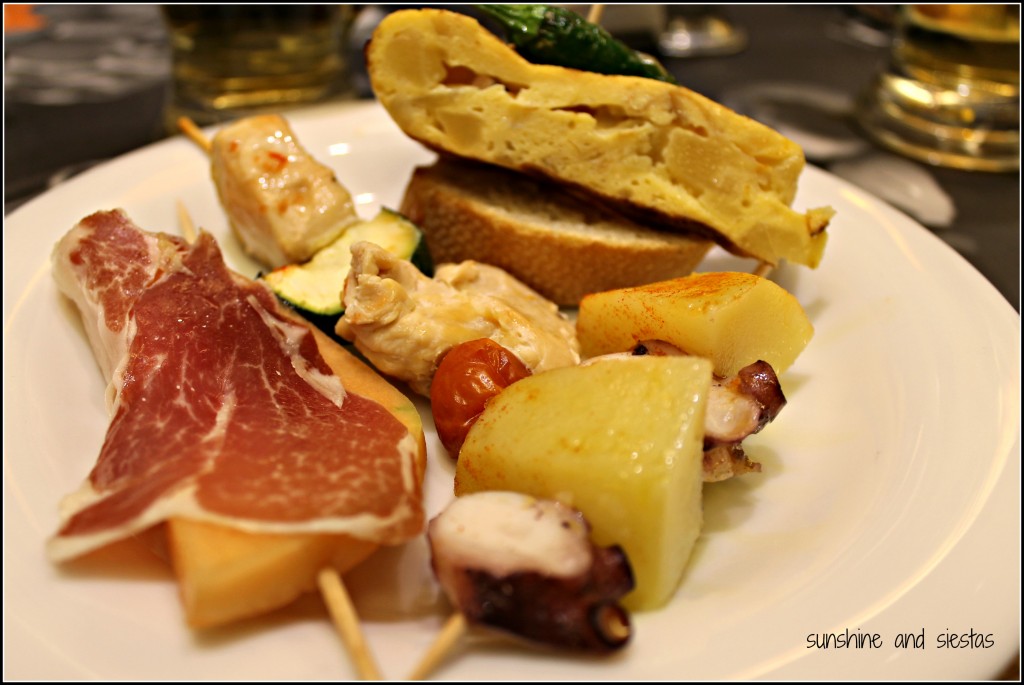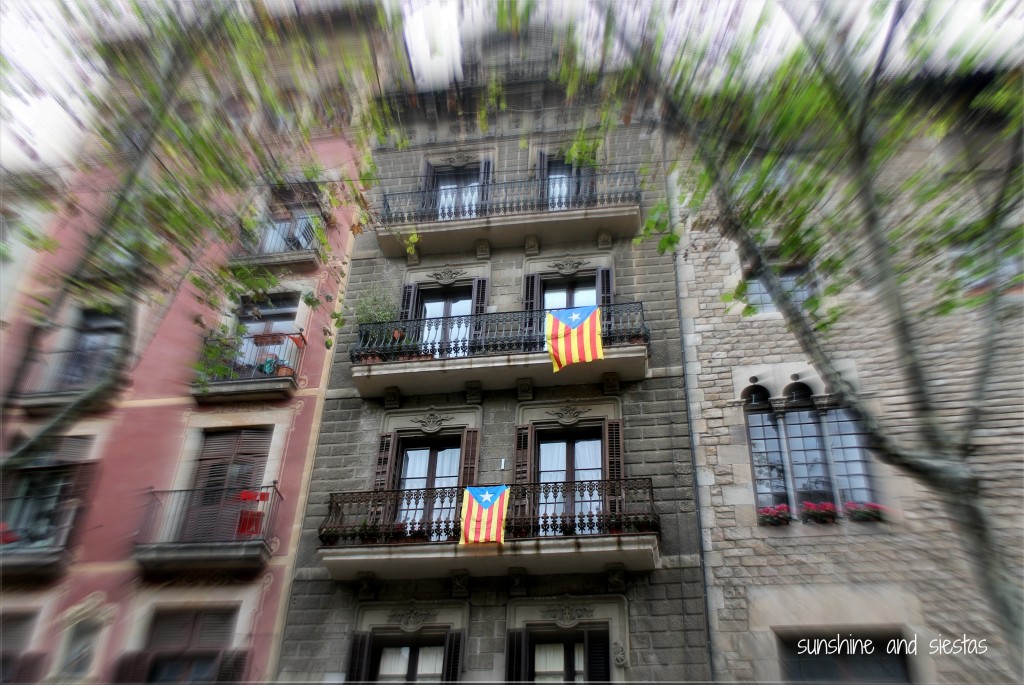Where we last left off, I had literally just climbed a mountain, but I had also scaled a mountain of self-doubt that told me my body was not strong enough to continue. We were halfway there, distance-wise, but coming to grips with the impending end of the journey.
Day Eight // Monday, August 5th, 2013 // Gontán – Vilalba //20km
Money can buy you happiness, it turns out, and we left Abadín before dawn after a few beers the night before and a sound sleep in a comforable bed to the tune of 19€ each. At this point, I’d only opened my sleeping bag once.
We didn’t speak much on the way to Vilalba, a once-powerful city that hosts a Parador. All of the sudden, there were more pilgrims on the trail who we’d never seen before, and we felt rushed to get to the next inn on time with Croissanthead (our so-named mascot for an earlier Xacobeo celebration). We had wine at the parador and met the cook, a man who had walked 15 Caminos in his life. I’d read somewhere that those who live along the trail are obligated by law to protect pilgrims and not do anything to ruin or impede their Camino. Written or not, pilgrims are respected by these townspeople, and not just for the tourism dollars they bring in. We were treated to a snack, courtesy of this fellow peregrino.
Even the local Proteccion Civil officer who ran the large albergue locked up 15 minutes later than normal because we invited him to a shot of orujo.
Day Nine // Tuesday, August 6th, 2013 // Vilalba – Baamonde // 20km
The reality of passing the halfway point in our journey was starting to weigh on me. The simplicity of pilgrim life was so inviting after a year of many changes and transitions for me, and knowing that I’d be finished in just five days got me a little depressed. I no longer befriended pilgrims, knowing I’d have to say goodbye to them once we reached Santiago. José was an exception. Sharing 20 kilometers with him into Baamonde was a treat.
The road that day was littered with small towns, dairy farms and leafy groves of trees and rudimentary stone structures. José is a secondary teacher in Valencia, so Hayley and I immediately had a connection with him and his outlook on life. Almost immediately after meeting another pilgrim, you exchanged the, ‘So what brings you on the Camino?’ question. José’s was simple, and it made me think of my own reasons.
The say the Camino always provides, and it does – from new friendships to a bit of clarity to a stronger body, or even a hot plate of food after a long trek.
That afternoon when we rolled into Baamonde, just 103 kilometers from Santiago, and we had ample time to enjoy the 94 others who were there sharing four showers with us. Afternoon beers, a large and tasty meal in a table that was far too small for us and our food, jam sessions in the patio as we waited out a rain cloud. When you only have one thing in common and nothing else matters, it’s easy to make friends. Besides, that’s what Facebook is for!
Day Ten // Wednesaday, August 7th, 2013 // Baamonde – Miraz // 14.5km
“Be careful of the Santa Campana,” Fernando warned us before retiring to bed. Our walk from the sprawling pilgrim’s inn at Baamonde to the rumored ‘nicest albergue on the Norte’ was a short one, but we’d have to rush – there were just 26 beds in Miraz.
We woke at 5am. It would be dark until nearly 7:30 a.m., but we didn’t have any time to waste. My guidebook told me that we’d walk three kilometers out of Baaaaaaaaaaamonde before turning left over the train tracks. Our flashlights bounced off trees, searching desperately before we got off-track and lost a bed.
Then it began raining. We thankfully didn’t see the witches of the Santa Campana, said to lure pilgrims into sorcery by handing them candles when it’s dark and rainy along the trail.
By the time we got to Miraz around 9:30 that morning, there were already six or eight other pilgrims in line. We set our bags down under the overhang, respecting the pre-established order for beds and joined the others in the town’s only bar. We considered continuing on to Sobrado, but I’m glad we didn’t – apart from a warm bed and blanket and other English speakers (the small albergue is run by the British Cofraternity of Saint James volunteers), we spent hours in the bar, warming up over beers and sandwiches. The rain and the fact that we had to wait forever was made better by the fact that there was a bit of cerveciña to make the time pass quicker.
Day Eleven // Thursday, August 8th, 2013 // Miraz – Sobrado dos Monxes // 25.5km
We took our time walking into Sobrado dos Monxes the following day, knowing that we were nearing the end of the road. It was a perfect day, with puffy clouds within reach and enough solitude to hash out issues and just talk about nothing in between.
The albergue is housed in a 10th Century monastery, and Hayley and I couldn’t help but draw comparisons to our weeks working in a haunted monastery in Uclés, Cuenca. The pilgrim hysteria was high, as a Jesuit group was also there, taking up nearly half the beds. After checking in and getting our stamp from the monks who lived on site and raised dogs and cows (which Carmela and I got to see!), Hayley and I escaped to a bar further outside of town. When we finished, half a bottle of wine each later, a stray dog who I’d tripped over earlier in the day was waiting for us, his broken chain dangling from his neck as he drooled over the hot pavement. We tried to lose him, and the poor pup kept getting shooed out of the monastery.
I honestly would have loved wasting hours petting him in the interior lawn of the sprawling, gorgeous palace, but he was not allowed to enter.
Long live Blacky. That is, if he stops tripping pilgrims.
Day Twelve // Friday, August 9th, 2013 // Sobrado dos Monxes – Arzúa // 22km
Fernando gave us a pep talk as we headed out of Sobrado towards Arzúa, the last major stop on the Francés and where our route would hook up with the main pilgrim trail. We’d lose most of our friends on this day who favored a shorter route that skipped the pilgrim town. Many bikers making their way to Santiago passed us, and we knew they’d reach Santiago in time for Pilgrim’s Mass that morning while we still had more than 50km to go.
Reaching Arzúa was a bit strange – there was already a long line outside the municipal inn when we arrived, despite making good time. Most of the private inns were booked up, too. In the end, a hotel offered us a good price for a street side room right near the central plaza.
‘You’ll need these,’ he said, handing us a pair of earplugs. I already had some, courtesy of the Novio, but I shrugged and took them anyway. We took long showers, ate a filling lunch and caught up on the news for the first time in days. Here in Arzúa, pilgrims are kings and there are loads of facilities for them. We had ample choices of where to eat, had special deals on laundry services and massages, and found ourselves feeling alone in a booming town – it took us ages to find familiar pilgrims.
Pilgrim culture shock at its finest.
Our second to last sleep was interrupted early the next morning by a bagpipe. The town had some sort of festival, hence the lack of private inns, and its last revelers were playing bagpipes to signal the end of the party. So that’s what the earplugs were for.
Day Thirteen // Saturday, August 10th, 2013 // Arzúa – O Pedrouzo // 19km
We wizened up and book a private pension again, not willing to hurry our penultimate day for sake of a cheap bed. This meant we could take our time walking, stop more often and really soak up the last few kilometers. By now, we were 41km away from the Plaza do Obradoiro, which we decided to split into two days.
This day was among the most enjoyable – frequently stopping for a beer, running into familiar faces, realizing we’d done 300 kilometers and were all but finished. Joining us were loads of bikers (we nearly got plowed into!), many families and scout groups, and even people pushing strollers! We saw the turigrinos – those who sent their packs ahead and just walked with little weight. I felt lighter than on any other day, and even the purge I’d do later that day of things I wouldn’t need or hadn’t used in two weeks seemed to lighten the load tremendously.
I realized that I’d done everything I intended to do on the Way, save arrive in one piece to Santiago.
Hayley stopped just ahead of me and pointed – didn’t you want to leave something at this mile marker? Once in Galicia, it’s easy to see how many kilometers are left until the cathedral because they’re all marked with the distance down to the thousandth. Exactly at 21,0km I left a purple and orange ribbon for Kelsey. I’d scatter several more the following day, too – at the Lavacolla airport, at Monte do Gozo and at Saint James’s tomb.
Day Fourteen // Sunday, August 11th, 2013 // O Pedrouzo – Santiago de Compostela // 21km
I slept terribly. Maybe I was anxious, but it could be because a homeless man walked into the albergue and took a shower, and then an obnoxious family who hadn’t walked much all took showers after 11pm, turning on lights and hair dryers after I’d already drifted into dreamland. I tried to read Shirley McClain’s The Camino, but it was full of weird mystical dreams and meeting random dead Scottish men who give her a locket and then there’s a big black dog that chases her and she sends him a big red heart of love in her bind of some shit.
Anyway.
I was grumpy, but we didn’t have time for it. Every step meant one second less of our journey, one second closer to the end. Memorials and statues were around every corner, and I felt like we were racing to get to the finish line (we did want to arrive by mass at noon). I made sure to stop in the chapel of Santa Lucia, following my protocol to always leave her a donation as my Catholic aunt told me I was to do if I took her name for my confirmation. I was emotional, about ready to burst at any moment.
It finally happened after reaching Monte do Gozo. After leaving a ribbon on the memorial to Pope John Paul II and stamping our passport for one of the last times, we started the trek downhill. I teared up, wiping away my emotion as Hayley warned me to get it together, or we’d never make it.
We stalled as much as possible without losing track of the time, which included shooting last-minute footage, splitting an Aquarius, stopping to admire a part of the city we hadn’t seen on previous visits. It was ending.
As we arrived to the old town, I was overcome with emotion – for the struggles, for Kelsey, for knowing that tomorrow meant Seville and life and the school year and social media. The bagpipe that I’d heard several times on previous visits rang out and I tripped over my feet. Within moments, we’d passed under the arch and into the morning sunlight. The lichen-covered church towered before us, and even though I’d seen it many times, it was more striking and more beautiful and just plain bigger than ever before. We laid down immediately, taking it all in, happy for the journey and the fact that our legs didn’t fall off.
We had 36 hours or so in Santiago, in which we drank beer, ate international food and paid out respects to Saint James. Hayley decided to shop for other clothes to wear on the plane, but I wore my smelly clothes home, concha attached to my bag. I was proud of it, and I wanted to it last until I was back home.
The thing is, the fact that I’ve seen and done something I’ve always dreamed about doing means that it’s going to last forever in my heart and my memories and my photos.
Yes, even this one: creepy doll heads in Lavacolla, just one of the weird things we saw in 325 kilometers.
Want more? My flickr page has every photo you could ever want to see, and I’m working on my first video! In the meantime, you can watch Hayley’s Camino video and tear up when I do when arriving to the Obradoiro (or laugh at how excited I get about a plate of lentejas)! To learn more about the Camino de Santiago, check out my resources page, or get your FAQs answered by Trevor of A Texan in Spain.
